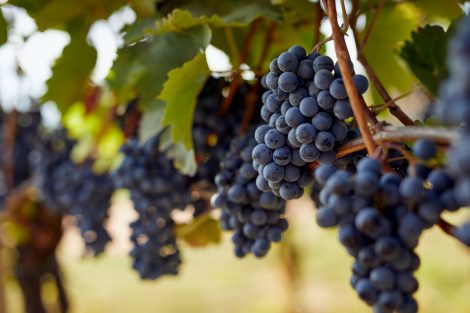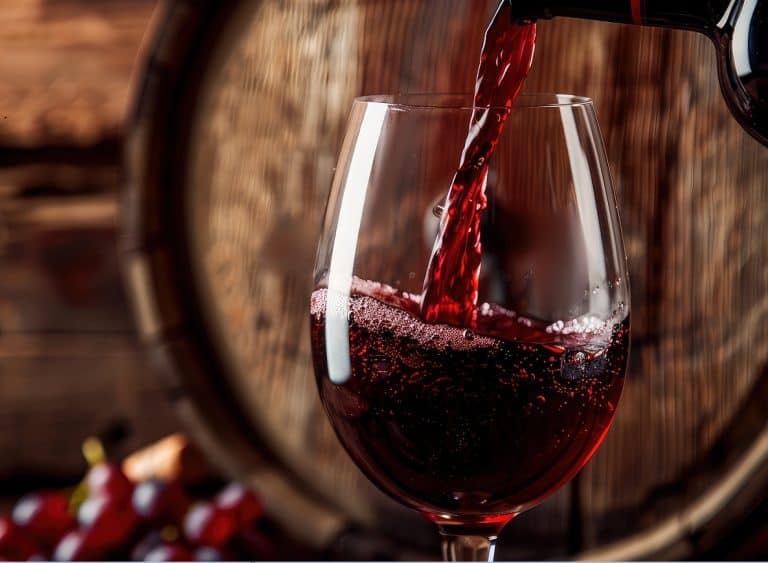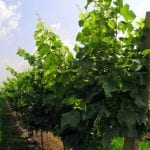Raboso del Piave is a red grape variety from the Marca Trevigiana, whose origins date back centuries. The earliest confirmed records date back to the 1600s, and it was during this period that raboso became famous as a "traveling wine" in the territories of the Venetian Republic. Thanks to its pronounced acidity and vigorous tannins, it was one of the few wines that resisted long ocean voyages without spoiling. The cultivation of the grape in the areas to the left of the Piave River continued until the end of World War II. At that time, about 80% of the red wine in the region was produced with raboso. Only in the 1960s did the trend of international grape varieties favor the gradual replacement of raboso with commercially more profitable grapes, such as cabernet sauvignon and merlot. Then, after about thirty years, some producers saved raboso from extinction, making its qualities known and appreciated.
Raboso is a rather rustic and robust grape variety, with a long vegetative cycle; it sprouts early and ripens late, towards the end of October. It adapts very well to alluvial, gravelly, and calcareous-clayey soils. Historically, it is cultivated only in the Treviso plain near the Piave River. The wine is characterized by important body and structure. When young, it presents aggressive tannins which, together with high acidity, make it rather angular and rough on the palate. Only long aging in wood manages to soften the more rugged aspects of its character and transform it into a powerful and harmonious wine.
It has an intense red color, aromas of marasca cherry and red fruits, with additional tertiary evolutionary notes. While maintaining good freshness and important tannins, raboso gains a broad and complex bouquet with aging in barrels, enriching fruity aromas with nuances of spices and tobacco. The finish closes with good sapidity and great persistence. Raboso del Piave rightfully belongs among the great Italian red wines for aging. It pairs perfectly with game in salmì, red meats prepared with long and elaborate cooking methods, grills, and important roasts.

The Best Raboso del Piave
Here are the Raboso del Piave wines that received Due Bicchieri Rossi or Due Bicchieri in the 2024 Gambero Rosso Wine Guide.
The long summer of 2016 allowed the harvest of perfectly ripe grapes, which were transformed into a splendid version of Raboso, a wine that reveals its aromas little by little: first the red fruit, then the spices, and finally the subtle balsamic nuances. In the mouth, the traditional acidic and tannic verve of the grape is elegantly controlled, and the sip unfolds juicy in a long finish. More complex, articulated, and restless is the Indigeno 2013. Luigi Peruzzetto and his son Jacopo run the family business just a stone's throw from the course of the Piave River, one of the most interesting realities of the area, covering just under twenty hectares. Here, on soils that alternate clay with gravelly layers as you approach the riverbed, international grape varieties find a home but also the most historical raboso, white marzemina, and some of the numerous crosses created by Professor Manzoni. Production puts raboso in the spotlight, interpreted with precision and rigor.
- Piave Raboso 2016 - Casa Roma
- Piave Raboso Indigeno 2013 - Casa Roma
- Piave Malanotte 2017 - Casa Roma
The Raboso 2020 by Giorgio Cecchetto captivates with its central fruitiness surrounded by delicate floral nuances and the discreet presence of oak on the nose. However, in the mouth, the wine changes pace, and the traditional aggressiveness of the grape is governed with elegance and the sweetness of the tannin, for a sip of great precision and harmony. More exuberant is the RP passito version, which follows overripe fruit aromas with a bewitching sweetness and a dry, clean finish. Giorgio Cecchetto, along with his wife Cristina and children Sara, Marco, and Alberto, leads what has become a true leading company in the Piave area. The vineyard area available is extensive, drawing from over 100 hectares that stretch between the gravel and clay lands around the winery in Tezze di Piave, Motta di Livenza, and Cornuda. Only a portion of the harvested grapes gives life to the house production, allowing Giorgio to select only the best batches, starting from the beloved and pampered raboso.
The Raboso 2019 by Stefano and Luigi Sutto is one of the wines presented this year that knows no weaknesses. If there is one aspect that strikes in the activity of the Sutto brothers, it is surely the speed with which they have been able to take their father Ferruccio's small company and transform it into one of the most important realities in the region. The extensive vineyard extends between the Treviso plain and the UNESCO heritage hills, with significant experience in the Collio Goriziano. To the historic cellar in via Arzeri, this year the new and modern structure of Col San Martino has been added, destined for the production of Prosecco Superiore.
Great attention is paid to the production of Raboso Potestà 2020 by Bonotto delle Tezze, the wine that more than others represents the company. Separate management of individual batches and different refinements provide the basis for a red wine of great charm where intense notes of ripe cherry echo balsamic nuances and slight spicy hints. In the mouth, the wine reveals all the verve of the Treviso grape, made of solidity, highlighted acidity, and tight tannin. In a territory that seems to have abdicated its ampelographic wealth for glera, Antonio Bonotto together with his wife Vittoria and son Luigi remains faithfully linked to the historical grapes of the territory, led, of course, by raboso. The historic cellar in via duca d'Aosta has recently been expanded and today allows each processing to be carried out with precision and at the right time. Wines with a straightforward style that express a productive idea focused on elegance and freshness of drinking.
- Piave Raboso Potestà 2020 - Bonotto delle Tezze
The Reposum Raboso by Tenuta San Giorgio is a passito obtained from pure raboso grapes. The Tombacco family runs the large estate in Maserada sul Piave, 85 hectares distributed over lands rich in gravel and clay. Alongside the inevitable Prosecco, there is the presence of the historic raboso: the Malanotte Bruma Nera '16 is a mature red of great richness.
The name Vignalta is indissolubly linked to that of the Colli Euganei, the volcanic area that extends south of Padua and where viticulture merges into a landscape where wooded areas and valley bottoms return a varied and low-impact agricultural profile. The productive heart develops between the hills of Baone and Arquà Petrarca, with more than 30 hectares dedicated mostly to Bordeaux varieties, but also including chardonnay, Manzoni bianco, or the historical moscato bianco and giallo.
The Piave Malanotte 2018 by De Stefani is one of the wines produced by Alessandro De Stefani, at the helm of the family business, a company structured on three viticultural bodies mainly distributed between the towns of Fossalta di Piave and Monastier, while for glera and marzemino one must venture into the hills of Refrontolo. The vast plain that stretches between the provinces of Venice, Treviso, and Pordenone is characterized by deep layers of clay that give way to gravel as you approach the course of the numerous rivers that cross it.
The Malanotte 2015 by Ornella Molon, thanks to partially dried grapes, plays with a sweeter and more expressed fruit. In the mouth, the typical roughness of the raboso grape is mitigated and accompanied by fullness. The plain that stretches between the provinces of Venice, Treviso, and Pordenone has always been a land of viticulture, where the arrival of phylloxera more than a century ago supplanted historical varieties, leaving behind the main international varieties. Today, glera is the protagonist of this strip of Veneto, but not in the Molon Traverso household, always faithful to the varieties that have brought quality and success. Brothers Stefano and Alex Traverso, with the collaboration of their parents Ornella and Giancarlo, follow all production and commercial phases.


 US tariffs: here are the Italian wines most at risk, from Pinot Grigio to Chianti Classico
US tariffs: here are the Italian wines most at risk, from Pinot Grigio to Chianti Classico "With U.S. tariffs, buffalo mozzarella will cost almost double. We're ruined." The outburst of an Italian chef in Miami
"With U.S. tariffs, buffalo mozzarella will cost almost double. We're ruined." The outburst of an Italian chef in Miami "With US tariffs, extremely high risk for Italian wine: strike deals with buyers immediately to absorb extra costs." UIV’s proposal
"With US tariffs, extremely high risk for Italian wine: strike deals with buyers immediately to absorb extra costs." UIV’s proposal Meloni: "Tariffs? If necessary, there will be consequences. Heavy impact on agri-food sector"
Meloni: "Tariffs? If necessary, there will be consequences. Heavy impact on agri-food sector" The Government honours the greats of Italian cuisine, from Bottura to Pepe. Massari: "Thank you, Meloni, the only one who listened to us"
The Government honours the greats of Italian cuisine, from Bottura to Pepe. Massari: "Thank you, Meloni, the only one who listened to us"







